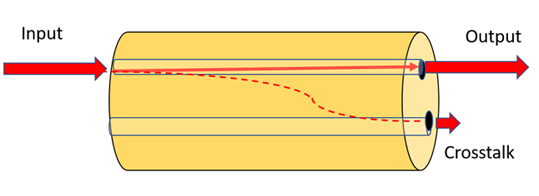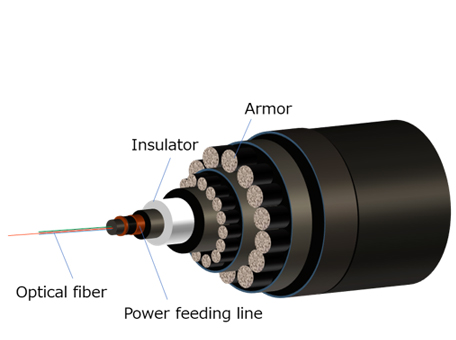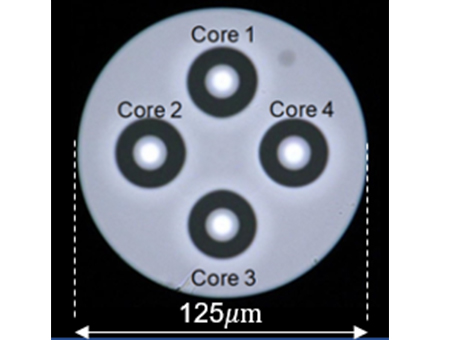Realization of Multicore Fiber with Low Crosstalk and Ultralow Attenuation Loss
- Demonstration of ultralong-distance transmission with current submarine cable size -
- Optical fibers and amplifiers for a high-capacity submarine telecom cable system were developed under a project commissioned by the Japan Ministry of Internal Affairs and Communications.
- Transmission beyond trans-Pacific distances is demonstrated in a four-core optical fiber with standard fiber dimensions.
- We support an increase in core count for submarine cable systems using space division multiplexing, using new technologies including the development of multicore amplifiers.
Furukawa Electric Co., Ltd. (Head Office: 2-2-3, Marunouchi, Chiyoda-ku, Tokyo; President: Keiichi Kobayashi) and KDDI Research, Inc. (Head Office: 2-1-15 Ohara, Fujimino-shi, Saitama Prefecture; President & CEO: Hajime Nakamura) have succeeded in developing low-crosstalk multicore fibers with loss values comparable to the world’s lowest levels (Furukawa Electric) and in transmitting ultrahigh-speed optical signals over greater than trans-Pacific distances through four independent cores (KDDI Research). This research has been supported by the Ministry of Internal Affairs and Communications (MIC), Japan under "Research and Development of Innovative Optical Network Technology for a Novel Social Infrastructure (JPMI00316) (Technological Theme II: OCEANS)".
We report the characteristics of the 4-core fiber, the transmission characteristics using this fiber, and the current status of the multicore amplifiers essential for future practical applications at the 46th European Conference on Optical Communication (ECOC2020), which will be held online beginning December 6 (Belgian Time).
Background
The data traffic stimulated by 5G, the IoT and remote work due to COVID-19 continues to grow. In addition, the demand for capacity in optical submarine networks for international communications continues to increase due to growth in the demand for communication between data centers. To meet this demand, space division multiplexing systems that increase the number of fiber cores in a cable are being deployed. It is unrealistic to increase the size of the outer diameter of cables above the current level because of installation difficulties and increased costs, so increasing the number of cores within the cable while keeping the outer diameter of the cable unchanged is necessary.
Details
A multicore fiber (MCF) is a fiber with multiple cores wherein optical signals propagate; MCF is installed in the same manner as standard optical fiber. The MCF that we developed has four cores and thus four times more capacity than standard optical fibers. An important issue in MCF is “crosstalk”, which is signal interference occurring between the cores in the fiber. It has been difficult to reduce crosstalk in MCF to a low level of attenuation loss comparable to that commercial submarine fibers. By optimizing the fiber structure and manufacturing method, we succeeded in developing an MCF that achieves an attenuation loss of 0.155 dB/km, equivalent to that of commercial submarine optical fiber, and exhibits low crosstalk of less than -60 dB/100 km.
This fiber is expected to be applied to ultralong-haul systems, including trans-Pacific submarine optical fiber cable systems whose maximum distance can exceed 9000 km. Using this newly developed ultralow loss MCF (ULL-MCF), we have demonstrated that it is possible to transmit ultrafast optical signals further than 12,000 km.
Reducing the power consumption of the fiber amplifier is also a major issue. We are currently developing multicore amplifiers (MC-EDFAs) for application in optical submarine systems. We will investigate space division multiplexing optical submarine systems that utilize our newly developed ULL-MCF and MC-EDFA.
Image of submarine cable

Cable structure example
Crosstalk
Crosstalk occurs when a small portion of the signal light from one core leaks into an adjacent core, appearing as an unexpected component in the adjacent core.
Reducing crosstalk is necessary to improve signal quality.
(A crosstalk level of -60 dB indicates that the crosstalk light intensity is one millionth of the output light intensity)

Outline of the research commissioned by the Ministry of Internal Affairs and Communications, Japan
| Name | “R&D Project for ICT Priority Technologies R&D on innovative optical network technology for new social infrastructure (JPMI00316) Technology theme II Multi-core high-capacity optical transmission system technology: OCEANS” |
|---|---|
| Implementation period | FY 2018 to FY 2021 |
Furukawa Electric Group’s efforts towards the SDGs
Based on the corporate philosophy of “Drawing on more than a century of expertise in the development and fabrication of advanced materials to contribute to the realization of a sustainable society through continuous technological innovation,” the Furukawa Electric Group is conducting business activities centered on four core technological capabilities (metals, polymers, photonics and high frequency). Moreover, keeping in mind the “Sustainable Development Goals (SDGs)” adopted by the UN, we formulated the “Furukawa Electric Group Vision 2030,” which clarified the business areas of the Furukawa Electric Group, and are advancing efforts aimed at “creating solutions for the new generation of global infrastructure combining information, energy, and mobility to build a sustainable world and make people’s life safe, peaceful, and rewarding.










 Share
Share Tweet
Tweet Share
Share